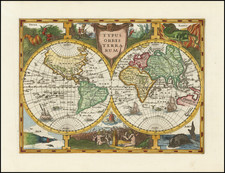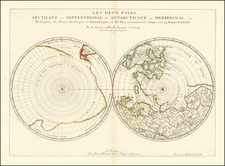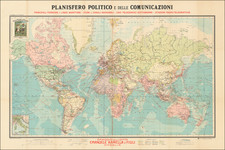Incorporating The Dutch Discoveries in Australia and New Zealand
Fine example of the final edition of Jan Cloppenburgh's double hemisphere map of the World, an important pre-Tasman map in the early mapping of Australia.
This map appeared in the enlarged edition of Mercator's Atlas Minor, published by Cloppenburgh.
In this final edition of the map, the western coast of Australia makes a very early appearance and is named T'lant van Eendracht. This is a very early depiction of a portion of the Australian continent, based upon the name of the ship which made the first landfall on the western Australian coast in 1616. 'Eendracht' meaning harmony or concord is found on other maps as an early name for the continent. The earliest such appearances of this information came only 2 years earlier and this is one of only a small group of maps to include the information.
Also in the Eastern Hemisphere, the Nile in Africa originates from twin lakes south of the equator, and Korea appears as a very skinny peninsula. America features numerous mountain ranges and large rivers with no Great Lakes, while South America is depicted with the two mythical lakes Lacus Parime in Guiana and Lacus Epana in Brazil.
The map is embellished with depictions of the four elements in the corners and Biblical scenes above and below. The map is further decorated with sea monsters and numerous tiny sailing ships.
First issued in 1630, this 1673 state of the map is the first to show the details in Australia and New Zealand, along with new information in the Indian Ocean.
Johannes Cloppenburg (sometimes Cloppenburgh; also H. Jan Evertsz and Johannes Everhardus) was a Dutch cartographer. Based in Amsterdam, he was active between roughly 1610 and 1644. He worked closely with the Hondius/Jansson firm and is credited with the 1630 edition of the Atlas Minor.












![[Signed Political Satire Artwork] Vietnam ... Vietnam ... Vietnam ...](https://storage.googleapis.com/raremaps/img/small/68726.jpg)

![[ Ancient World ] Aevi Veteris, Typus Geographicus](https://storage.googleapis.com/raremaps/img/small/85526.jpg)
![[From the Library of Captain Louis Freycinet] Carte Hydrographique Des Partes Connues De La Terre Dressee sur la Projection de Mercator, Poar C.LO. Gressier , Ingenieur Hydrographe de la Marine . . . 1835 (with extensive manuscript annotations)](https://storage.googleapis.com/raremaps/img/small/58604.jpg)